
Shaku Nair, Dawn H. Gouge, Shujuan Li
Department of Entomology, University of Arizona
Flies belong to the insect order Diptera, which is one of the most diverse insect orders (Figure 1) and a group that is of great significance to humans. Flies impact human and animal health, and regional economic stability and ecology. Some species are biting pests that vector disease causing organisms, some are important crop pollinators, while some are crop pests, and some are scavengers of organic decaying matter serving an important role as decomposers.

The robust 2021 monsoon season has provided some relief to many drought-stricken areas of the southwest including Arizona. In many places, the sudden heavy rainfall led to flooding. Rich organic matter deposits from floodwater, flourishing vegetation and warm temperatures create the ideal environment for an outbreak of some dipterans known as filth flies, owing to their affinity for filth or decaying organic matter. These include house flies, flesh flies and blow flies. Other common flies include drain flies, phorid flies and fruit flies.
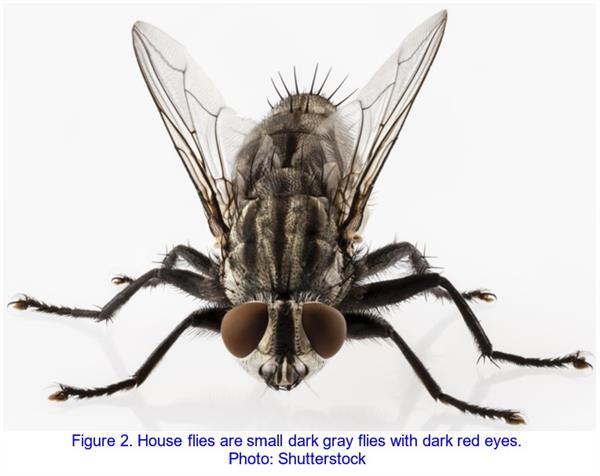
House flies are the most common domestic flies and are found all over the world. The adults are small dark gray flies, about ¼ inch in length. They have dark red eyes and a light grayish-tan colored abdomen. The thorax has dark stripes that run lengthwise (Figure 2).
House flies do not bite or sting but they can be extremely annoying, when flying into homes and settling on food and other surfaces. They transmit several microorganisms including those causing diarrhea, dysentery, typhoid, food poisoning, cholera, and eye infections. They mechanically carry these pathogens on their body surfaces and hair, as well as within their digestive tracts, expelling them through saliva, vomit and feces. House flies have extremely short life-cycles (Figure 3), taking about 15 days to develop from egg to adult under temperatures of 25 - 30oC. The females lay hundreds of eggs, and live for over a month, so populations can easily explode in 2-3 months of favorable conditions. House fly larvae develop in 50-60% moisture levels so extreme heat is not ideal for their development.
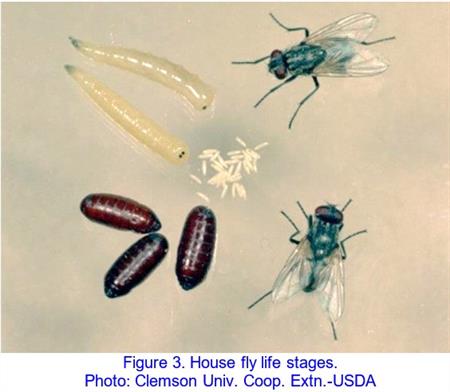
House fly look-alikes
Little house flies are smaller than house flies and can be distinguished from common house flies by the lack of distinct stripes on the thorax (Figure 4). They are more common during the cooler months and their numbers diminish as the temperatures rise during summer. They do not enter indoors as frequently as common house flies but prefer outdoor areas close to homes such as patios, porches, and garages. They often hover at face height, causing great annoyance during outdoor activities near homes. They are not regarded as significant carriers of human pathogens.
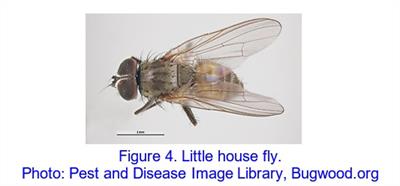
Stable flies are more of an animal problem in dairy and livestock facilities, than a human concern. They are very often confused with house flies and they also have the dark stripes on the thorax, but are lighter colored, have a wider abdomen with spotted pattern (not checkered), and a bayonet-like mouthpart (proboscis) protruding from the front of the head (Figure 5). They rest at an angle to the surface, with head raised above abdomen, whereas house flies rest with their abdomen flat and parallel to the surface (Figure 6). Both male and female stable flies feed on blood, and their bites are painful and irritating. They are most abundant in locations close to stables, as their name suggests, or where horses or cattle are maintained, and will also attack dogs and other domestic animals in these locations. They prefer to feed on the legs and lower body in cattle, horses and humans, but in dogs and smaller animals, they feed on the external ears. Although they are blood feeders, stable flies are not a significant cause of concern as carriers of disease-causing pathogens. However, they are known to carry and spread several of these microorganisms, including certain trypanosomid parasites, and bacteria causing anthrax, Lyme disease and bartonella.
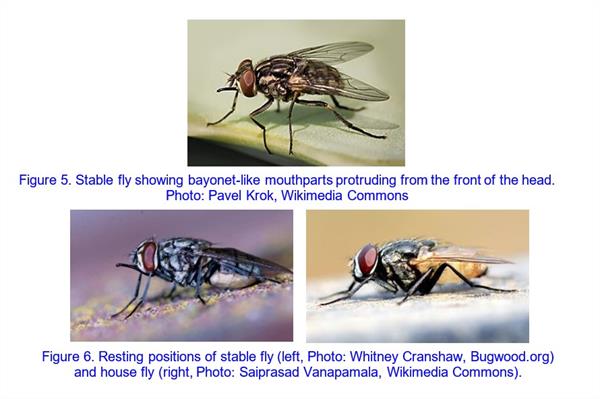
Flesh flies are often mistaken for houseflies due to their color, habits and habitats, but most species are much larger than house flies, reaching up to ½ inch in length. Adults have three dark stripes that run lengthwise on the thorax and abdomen has a gray checkered pattern, often with a red tip (Figure 7). The majority of flesh flies are scavengers, feeding and breeding in carcasses of various other organisms. They also thrive in decaying vegetable matter and excrement, and can be found around compost pits and poorly maintained toilets and pet waste.
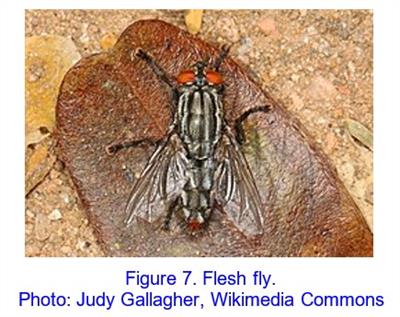
Other filth flies
Blow flies are easily distinguished from other filth flies, by their shiny, metallic blue, green or bronze coloration (Figure 8). They are mostly larger than house flies, reaching up to ½ inch in length. They feed on carrion or other decaying organic matter, especially feces, and are very common in dog parks, as well as around other animal droppings or manure.
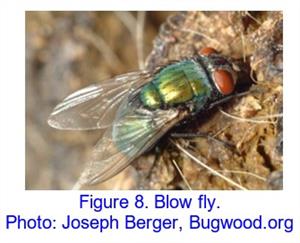
Phorid flies are small flies, about 1/16 th to 1/8 th inch in length, yellowish-brown to gray in color, with a small head and dark eyes. When viewed from the side, they have a humpbacked appearance from the prominent hump on the thorax (Figure 9).
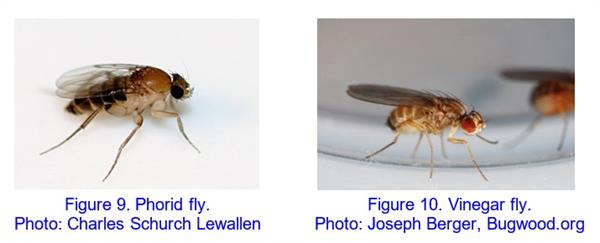
They are often found in many of the same outdoor locations as the other filth flies, and also indoors, readily feeding on a wide variety of decaying organic material. When disturbed, phorid flies can be seen scuttling across surfaces in short, jerky movements (because of which they are sometimes called scuttle flies) rather than flying, and this can help to distinguish them from other flies. They are seen frequently near drains with a deposit of rich, moist organic matter lining the insides, and are therefore sometimes called drain flies.
Vinegar flies or fruit flies are tiny flies, about 1/16 th inch in length, yellowish-brown or tan in color, with transverse dark bands around the abdomen. Males are slightly smaller and have a distinct dark patch at the end of the abdomen. Eye color can vary, but red is common (Figure 10). Adults are always found in and around fruit, vegetables, or any other sugary or fermenting organic material.
Drain flies or moth flies are tiny flies, about 1/8 th inch in length, dark-grayish brown in color, with long feathery antennae and furry, leaf-shaped wings covered with soft hairs, giving them a miniature moth-like appearance. These hairs leave a powdery residue if the fly is crushed. Adult flies can fly, but weakly in short, hopping movements. The adults are usually nocturnal and found in damp environments in homes and other structures that contain organic debris such as bathroom and kitchen sink drains, showers, laundry and floor drains. They may also be found outdoors, near storm drains, sewer sump pits, or other moist decaying organic matter.
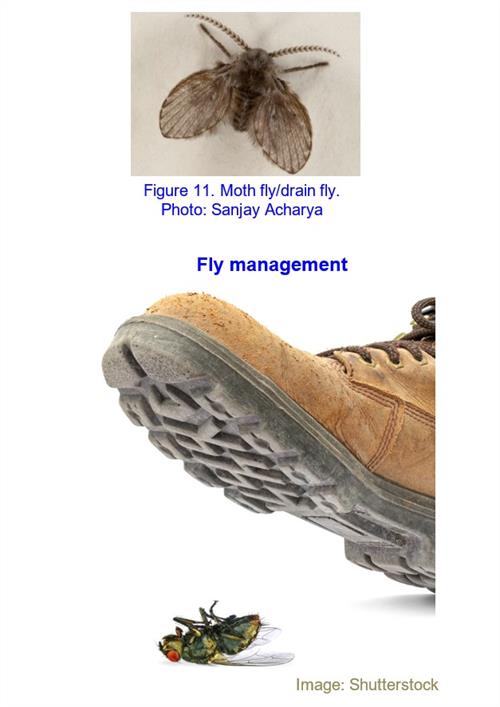
Here are some tips for fly management in and around homes and buildings.
Waste management is fly management! Timely sanitation and trash disposal go a long way in keep flies away.
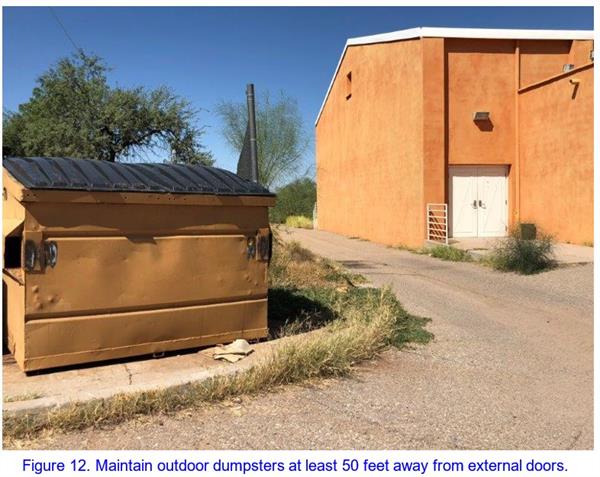
Pest proofing is your first line of defense to keep flies and many other pests out of your homes and buildings. Maintain door sweeps and seals, weather stripping and door and window screens in good repair. Seal cracks and gaps around doors and windows.
Read more about pest proofing in our publication available here: https://extension.arizona.edu/sites/extension.arizona.edu/files/pubs/az1677-2015.pdf
Grasshoppers and their nymphs (young ones) can be found year round in Arizona, but occur in large numbers during late summer and fall. Watch out for some of these fascinating species – the dull brown pallid-winged grasshopper (Figure 13) that blends well into the desert landscape, and the spectacular horse lubber grasshopper with its striking black, yellow and green colors (Figure 14).
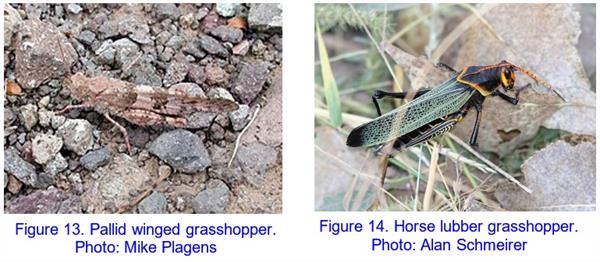
Grasshoppers are typically ground-dwelling insects with powerful hind legs which allow them to jump considerable distances and escape predators or other threats. They are plant feeders, and some species are serious pests of crops.
“National Preparedness Month is an observance each September to raise awareness about the importance of preparing for disasters and emergencies that could happen at any time. The 2021 theme is ‘Prepare to Protect. Preparing for disasters is protecting everyone you love.’
Each week during National Preparedness Month will focus on a theme with easy-to-follow steps that individuals and families can take to enhance their emergency preparedness efforts. This year's weekly themes include:
Ready.gov/September has free resources online, including social media content in multiple languages, for public use. Help spread the word of how to be prepared for disasters and emergencies before they happen. For more information, visit Ready.gov and Listo.gov.
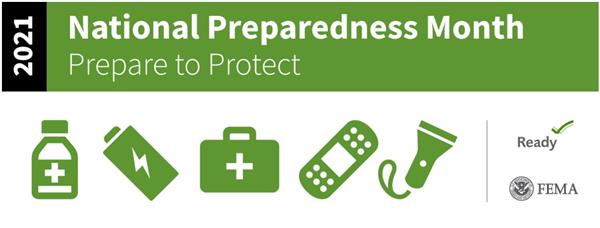
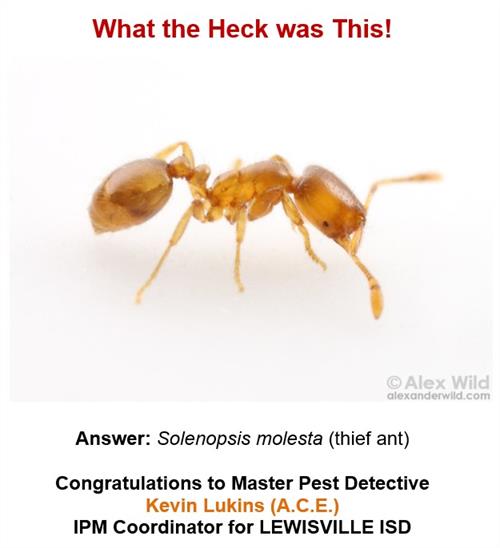
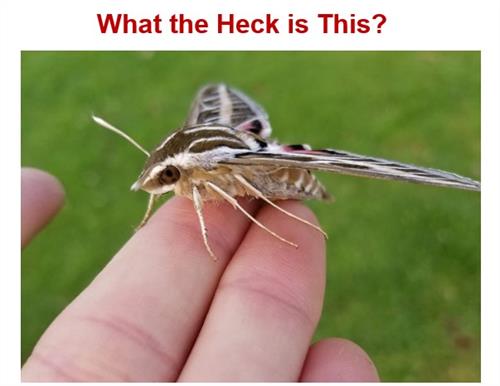
If you know what these are email the answer to Dawn at dhgouge@email.arizona.edu. You will not win anything if you are correct, but you will be listed as a “Master Pest Detective” in the next newsletter issue.
IPM APPROACHES FOR HEALTH CARE FACILITIES (90-minute webinar): Tuesday, September 21, 2021.
Health care facilities must maintain a clean, pest-free environment while caring for sensitive populations. This webinar will discuss how facilities can support the wellbeing of their patients by implementing an Integrated Pest Management (IPM) program that limits both pests and pesticides. Presenters will share science-based approaches to pest management that integrate cultural controls (i.e., practices that discourage pest invasion), biological controls (i.e., the use of beneficial organisms to manage pests) and chemical controls (i.e., the use of pesticides). Presenters will also highlight the importance of working collaboratively with contracted pest management professionals.
Register at https://register.gotowebinar.com/register/1824847770943250699.
View recordings of previous EPA Integrated Pest Management Webinars at https://www.epa.gov/managing-pests-schools/upcoming-integrated-pest-management-webinars.
For more information about the EPA Schools program: http://www.epa.gov/schools/.
To view all our previous newsletters, visit: https://acis.cals.arizona.edu/community-ipm/home-and-school-ipm-newsletters.
This material is in part funded by the National Institute of Food and Agriculture, U.S. Department of Agriculture, under award number 2017-70006-27145 that provides Extension IPM funding to the University of Arizona. Information regarding this document is within the guidelines of the Border 2020 Program funded by the U.S. Environmental Agency (EPA) and administered by NADB. Additional support is provided by the U.A. – Arizona Pest Management Center.